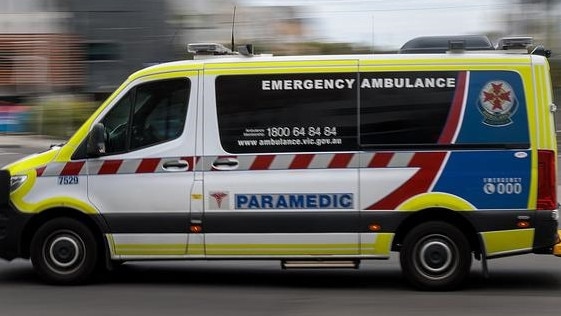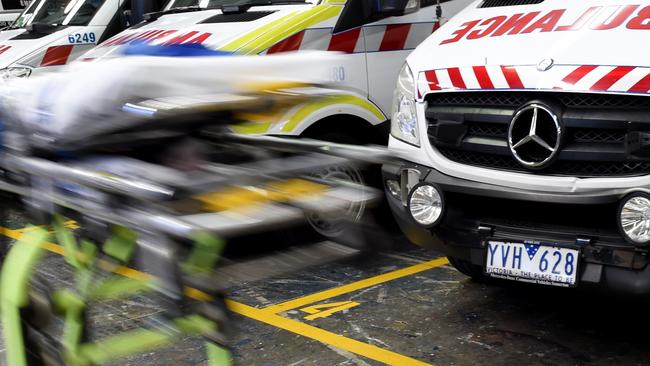Ambulance Victoria sent to pigeon, pregnant cat over humans
A pigeon in cardiac arrest, a cat in labour and a battle with hiccups are among the crazy cases paramedics have been called to, putting genuine patients at risk.

Victoria
Don't miss out on the headlines from Victoria. Followed categories will be added to My News.
Ambulances have been sent to sick pets, hiccups, toothaches and other non-urgent triple-zero cases, a peak union says, leaving genuine patients at risk.
They warned crews, at times via lights and sirens, have been repeatedly sent to non-urgent cases, including on nights when Ambulance Victoria called an internal emergency because of “extreme demand”.
Victorian Ambulance Union general secretary Danny Hill said in recent weeks, crews have been sent to people who called about hiccups, toothaches, a pigeon in cardiac arrest, a cat in labour and a person who was heartbroken after their cat died.
“We had one person call up and it was thought a person was in cardiac arrest,” he said.
“When crews got there it was a pigeon.”
He told the Herald Sun an ambulance was even sent to a woman in labour — discovered to be a cat — one night in May, during a code orange.
A senior MICA paramedic, who asked not to be named, said there would be “at least” one case every day, where specialised MICA crews tied up with a lower-acuity case cannot reach people who need “critical care assistance”.
“That failure to provide that within that half an hour or hour in that out of hospital phase is really important to their outcome,” they said.
“We’re not talking once a month here, I’d be amazed if it wasn’t once a day.
“It’s regular.”

They said taking just one crew out of action left large regions without MICA coverage.
“It’s not uncommon to have a single MICA platform in the entire western suburbs over night, or the entire northern suburbs,” they said.
“Once they’re taken out of action, we then have no intensive care coverage for hundreds of thousands of people.”
An experienced calltaker, who did not want to be named, said non-urgent cases were wrongly labelled as lights and sirens by their triage program’s rigid questions “multiple times a shift”.
“That’s an extra resource that’s been taken away from someone who may legitimately be having an emergency,” she said.
Mr Hill said it was a patient and crew safety issue and he was also aware of cases where intensive care paramedics were “unable to respond to really life-threatening cases” because they were tied up elsewhere.
“Patients are put at risk when crews are sent to cases they shouldn’t go to,” he said.
“Our members are saying we have enough paramedics for genuine emergency work.
“It’s hugely frustrating, we had the death of two paramedics many years ago driving lights and sirens under emergency conditions to what ended up being a low-acuity case.”
It comes just days after the union ramped up their industrial action as part of lengthy EBA negotiations, where paramedic’s forced overtime – averaging a collective 800 hours every day – and burnout has been a sticking point.
Ambulance Victoria has repeatedly failed to meet its response times targets for urgent code one cases.

But Mr Hill said, if Ambulance Victoria and Triple-Zero Victoria worked together to reform the system, “their response times would probably be really good”.
“The biggest improvement AV can deliver itself … is to make sure that they’re being sent to the right cases,” he said.
Two thirds of paramedics surveyed by the VAU last year said just one in five ‘lights and sirens’ cases they responded to, had a dispatch code that “aligned with” the patient’s condition.
Mr Hill said the fault was not with call-takers – who were also frustrated by the issue – but the program they use, which “over-triaged” cases and left little room for workers to ask for more details if they suspected something was not right.
“This is not them, they are doing their job correctly,” he said.
The calltaker said they have to ask about chest pain even when they knew it was an inappropriate question, meaning the system triaged someone with pain from coughing as a cardiac event, assigning it ‘lights and sirens’.
“Because of the nature of the program that we use, we’re not allowed to apply that common sense” they said.
“It’s a gross misuse of emergency resources.”
They said call-takers, dispatchers and paramedics all knew the system did not work.
“AV and TZV know it’s broken, but they won’t do anything about it,” they said.
An Ambulance Victoria operational communications executive director Anthony Carlyon said they had a “statewide, consistent and evidence-based call-taking and dispatch system, which is used by thousands of ambulance services worldwide”.
“We encourage anyone who calls for an ambulance to provide accurate information to ensure they receive the right care and allow our highly skilled ALS and MICA paramedics to be available for patients most in need.”
A Triple Zero Victoria spokeswoman said triple zero was “never” the right place to seek help for an animal, and urged people to only call “when someone needs urgent medical assistance, their life or property is threatened, or they have just witnessed a serious accident or crime”.
“All Triple Zero (000) calls for an ambulance undergo a structured triage process to determine each patient’s individual requirements with questions determined by Ambulance Victoria, and under this process an ambulance request for an injured pet or any other non-emergency will not be treated as an emergency,” she said.
“Triple Zero operators then process the information provided to determine the most appropriate response, which can include the dispatch of an ambulance or a referral to a nurse or a paramedic in Ambulance Victoria’s Secondary Triage.”
More Coverage
Originally published as Ambulance Victoria sent to pigeon, pregnant cat over humans




